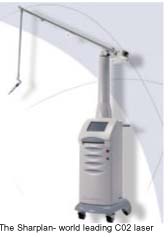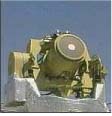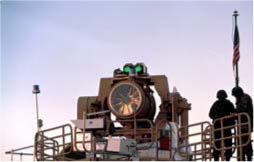These innovative lasers are now marketed globally, with annual sales of $350 million in 2002. One individual stands out in the field. Professor Isaac Kaplan, a brilliant surgeon, (whose reconstructive surgery helped to restore the bodies of wounded soldiers), has also been an important researcher and innovator. In the 1970s, early in the history of the development of medical lasers, he focused his attention on research, which resulted in the development of a broad line of carbon dioxide surgical lasers. This gave birth to an important high-tech industry. After overcoming the technical difficulties, several thousand of the carbon dioxide surgical medical lasers were sold worldwide.
In the 1980s, former President Ronald Reagan announced his vision of a world, where nuclear weapons would be made "impotent and obsolete", through effective defences against ballistic missiles. Reagan's "Strategic Defense Initiative (SDI)", quite controversial in its time, was meant to produce a complex system of lasers in space, designed to destroy Soviet nuclear missiles, before they reached the American continent. SDI resulted in one of the largest military research programs in history.
The sum of $40 billion did not produce a system able to intercept nuclear- armed ballistic missiles, but it fathered a number of defensive systems which may provide the answers against the threats of nations, that have acquired medium and long-range missile capabilities.
The United States and Israel, over and beyond their partnership in the development of the Arrow, have been collaborating on the development of high-energy lasers. Early this November the practical results of these efforts were realized.
A world's first, a high-energy laser, developed by TRW (NYSE: TRW) for the U.S. Army and the Israel Ministry of Defense, successfully intercepted an artillery projectile and caused it to explode harmlessly in the air.
The shootdown took place during a live-fire test of the TRW-built Mobile Tactical High-Energy Laser (MTHEL) testbed, conducted by the U.S. Army, at its White Sands Missile Range. The laser tracked and locked on the shell, before firing into it a stream of concentrated light energy photons and destroying it.
"This shootdown shifts the paradigm for defensive capabilities. We've shown that even an artillery projectile hurtling through the air at supersonic
speed is no match for a laser," said Lt. Gen. Joseph M. Cosumano, Jr., Commanding General, U.S. Army Space and Missile Defense Command. "Tactical high-energy lasers have the capacity to change the face of the battlefield."
The shootdown occurred as part of a new series of tests to determine MTHEL requirements and demonstrate the system's capabilities against a wide range of airborne targets. In earlier tests during 2000 and 2001, the testbed, then called the THEL Technology Demonstrator- focused on the threat of artillery rockets and succeeded in shooting down 25 Katyusha rockets, fired singly and in salvos.
TRW developed the MTHEL testbed under contract to the U.S. Army, for the joint US Army and Israel Ministry of Defense THEL ACTD program. "We look forward to producing a prototype of a truly mobile version and operational tactical laser weapon as the MTHEL program gets underway," said Tim Hannemann, president and CEO of TRW Space & Electronics.
With Israel's proven experience in the field of laser sensors, the country's defense establishment will be testing how to implement the Mobile Tactical High-Energy Laser and thus enhance the country's ability to protect itself from missiles that might be launched from Iraq or Iran.
 Driven by the fundamental belief in the sanctity of life, Israeli doctors, surgeons, engineers and technologists, have worked together for the past 30 years, turning this country into a center of medical advances. Among the important innovations is the development of unique medical lasers.
Driven by the fundamental belief in the sanctity of life, Israeli doctors, surgeons, engineers and technologists, have worked together for the past 30 years, turning this country into a center of medical advances. Among the important innovations is the development of unique medical lasers. In recent years, Israel has turned its focus on military lasers. The rationale was, that lasers could provide the country with an extra added dimension of protection from neighbors who did not possess nuclear capabilities, but have adopted medium and long term missiles as a threat to the security of the Jewish State.
In recent years, Israel has turned its focus on military lasers. The rationale was, that lasers could provide the country with an extra added dimension of protection from neighbors who did not possess nuclear capabilities, but have adopted medium and long term missiles as a threat to the security of the Jewish State. When President Bill Clinton was elected to the White House, all that the Star Wars planners had to do was to change the name plate at their windowless headquarters in the basement of the Pentagon. The former Strategic Defense Initiative Organization (SDIO) now operates as the Ballistic Missile Defense Organisation (BMDO) - its objectives remain virtually the same. While SDIO focused on systems based on satellites in outer space, BMDO is looking predominantly at earth-based rockets designed to destroy nuclear missiles on the way to their targets. In the Middle East, as an American led war against Iraq becomes ever more imminent, the threats posed to Israel are not from nuclear missiles but from those carrying WMD in their warheads.
Military analysts generally agree that when the US attacks Iraq, Saddam Husein's first response will be to order a missile attack against Israel. Unlike 1991, when 39 Iraqi Al Hussein Scuds landed in Israel, mostly in the Tel-Aviv area, this time it is expected that the missiles will carry warheads armed with lethal chemical and biological agents, with a potential for mass destruction.
Israel's main deterrent against the dangers from a "dirty" missile attack is its $2.0 billion Arrow Anti- Ballistic Missile. Its development began in the early 1990s and in 1998 it had its first successful deployment. The Arrow is the world's first ABM system, which is specifically developed to destroy incoming missiles.
When President Bill Clinton was elected to the White House, all that the Star Wars planners had to do was to change the name plate at their windowless headquarters in the basement of the Pentagon. The former Strategic Defense Initiative Organization (SDIO) now operates as the Ballistic Missile Defense Organisation (BMDO) - its objectives remain virtually the same. While SDIO focused on systems based on satellites in outer space, BMDO is looking predominantly at earth-based rockets designed to destroy nuclear missiles on the way to their targets. In the Middle East, as an American led war against Iraq becomes ever more imminent, the threats posed to Israel are not from nuclear missiles but from those carrying WMD in their warheads.
Military analysts generally agree that when the US attacks Iraq, Saddam Husein's first response will be to order a missile attack against Israel. Unlike 1991, when 39 Iraqi Al Hussein Scuds landed in Israel, mostly in the Tel-Aviv area, this time it is expected that the missiles will carry warheads armed with lethal chemical and biological agents, with a potential for mass destruction.
Israel's main deterrent against the dangers from a "dirty" missile attack is its $2.0 billion Arrow Anti- Ballistic Missile. Its development began in the early 1990s and in 1998 it had its first successful deployment. The Arrow is the world's first ABM system, which is specifically developed to destroy incoming missiles.